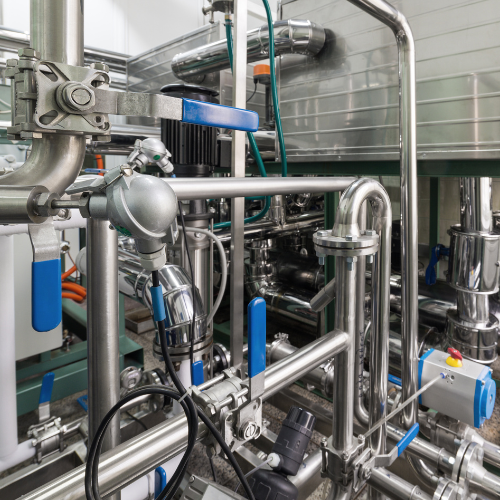Dehumidifier: For Defrost Cycles
Is your facility struggling with high relative humidity levels? Are you noticing dripping, excessive moisture, or the accumulation of mildew? Is moisture regain affecting the quality of your product? A dehumidifier can help resolve all of these issues.
THE KEY TO A MOISTURE-FREE FACILITY
Whether your facility is a manufacturing unit, food processing business, or a seed storage space, a dehumidifier is a critical piece of equipment designed to address excess moisture everywhere in a facility—from process rooms and docks to storage coolers — by removing fog and condensation, and eliminating ice and frost build-up on floors, evaporator coils and products.
While a dehumidifier requires additional energy to operate, in refrigerated rooms the moisture-absorbing capability of a dehumidifier will reduce the number of evaporator defrosts required.
How can a dehumidifier fit into your scheme of things?
Did you know that humid air is really sneaky? It can infiltrate into old, poorly sealed buildings, storage spaces, cooled docks, and nearby freezers to spread the moisture. Further, humid air infiltration contributes to roughly 90 percent of the total moisture load in your facility. The excess moisture can create various problems, like the accumulation of mildew, overhead ice formations, and even slippery floors.
The dehumidification system can be used as a building envelope if your building suffers from ventilation issues, can prevent dock door infiltration, and can be suitably positioned to keep process-related humidity away from storage spaces.
How does a dehumidifier work?
Simply put, a dehumidifier absorbs the excess moisture from the air in your facility. Depending on the mechanism used, dehumidifiers can be divided into two categories: desiccant dehumidifiers and mechanical refrigeration dehumidifiers.
Desiccant dehumidifiers
Desiccant material inside this humidifier has the ability to absorb water. When the air passes through, it absorbs excess moisture from it and pushes the air back into the facility. To make sure that the desiccant material works efficiently, a dedicated hot air stream is used to dry the material, rejuvenating its absorption capacity once more. This system is known as a regen process and is repeated multiple times within the system.
Depending on the method used to complete the regen process for the material, desiccant dehumidifiers are further classified into electric reheat, gas reheat, and waste heat reheat units. These units are simple in design, effective at removing moisture at lower temperatures and provide an excellent opportunity to reuse the waste heat from your facility during the regen process.
Mechanical refrigeration dehumidifiers
These humidifiers use refrigerant coils to complete the same process as a desiccant humidifier. When the air is passing through the dehumidifier, it comes in contact with the cooled coils which cool the air below its dew point to pull the moisture out of the air. The water condenses on the coil’s surface and the moisture-free air is then pushed back into the facility.
Selecting the best unit for your needs
Choosing the right dehumidification unit for your facility requires analyzing the needs and requirements of the space and your products. Some of the critical factors to keep in mind: what is the desired air temperature, the moisture content of the product during the chilling process, the rate and amount of moisture that is being added, and the level of humidity that would ideally need to be maintained.
Applications
A dehumidifier can become an integral part of your food processing, manufacturing and storage facility by enhancing productivity within your process rooms, docks and storage coolers. The dehumidifier will remove the moisture from the air before it has a chance to get into the cooler/freezer at your facility. By removing excess moisture from the facility, the product minimizes defrost cycles, enhances the operating performance of machinery-like spiral freezers- by removing fog and condensation, and ice and frost build up on evaporation coils. It also helps build a comfortable environment in your cold storage and aids in improving product quality. Installing a dehumidifier will also ensure that you are able to create a safe and comfortable working environment in your cold storage and production facilities.
It’s a win-win solution
Not only will an efficient dehumidification system aid you in keeping excess moisture at bay, but it will also bring savings in electricity consumption, and a decrease in utility bills. You will also notice benefits and savings in your operating expenses through:
Saving on electricity consumption at the unit
Increasing efficiency through improved water vapor control
Ensuring quality improvement as it ensures that the moisture does not result in the softening of the cardboard and boxboard boxes
Proper humidity control can reduce the potential of wet or icy floors in turn reducing risk of injury.
Get in touch with our team of experts to learn more.
CDI Food Spiral
CDI Dry Dock
CDI Food HVAC
Blog Post
.png?sfvrsn=692ec322_2)
If your facility is struggling with excess moisture related issues, it would be showing you signs and symptoms. A quick check at your facility can help you to identify these warning signs:


.png?sfvrsn=b02fc322_0)


.png?sfvrsn=26cbdc22_3)